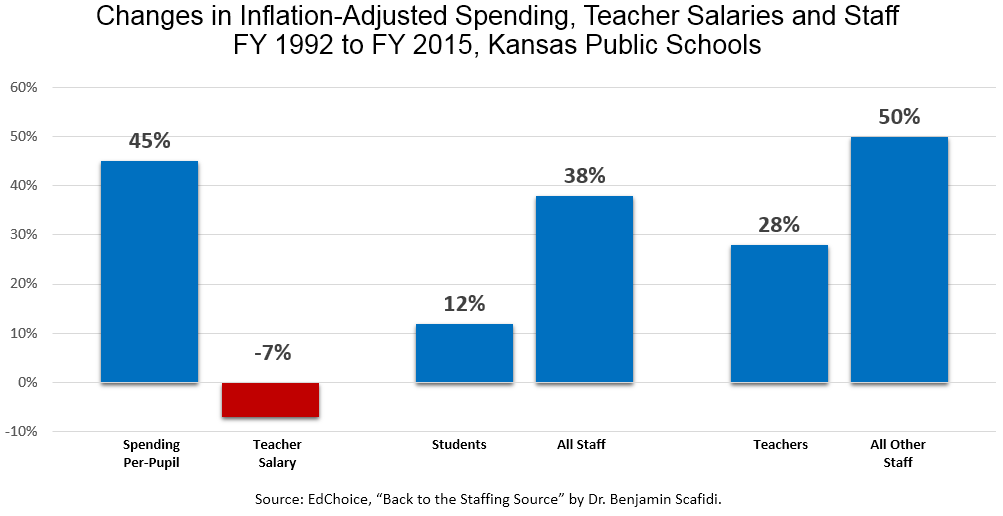Kansas Association of School Boards (KASB) chief lobbyist Mark Tallman’s recent post says teacher pay is too low, but he left out one important detail – low teacher pay is a conscious decision of local school board members. Tallman cites teacher pay estimates from the National Center for Education Statistics showing average teacher pay is about $4,000 below inflation-adjusted levels since 2010.
The implication, of course, is that taxpayers and legislators are to blame for underfunding schools, but the blame lies squarely on spending decisions by administrators and school board members. Legislators approve funding, but local school board members decide how to spend the money with input from school administrators.
A 2017 academic study conducted by Dr. Benjamin Scafidi on behalf of EdChoice (formerly the Friedman Foundation for Educational Choice) found inflation-adjusted per-pupil spending in Kansas increased by 45 percent between 1992 and 2015, but inflation-adjusted teacher salaries declined by 7 percent. The money was there; school board members simply decided to spend it otherwise.

Hiring additional staff was perhaps the largest diversion of money from teacher pay. With a 12 percent increase in headcount enrollment over the same period, Kansas school boards hired 28 percent more teachers, and they increased all other staff by a whopping 50 percent. Dr. Scafidi estimates the money that would be saved if ‘all other staff’ had increased with enrollment (at just 12 percent) would be enough to give every Kansas teacher a permanent pay increase of $13,708.
Education officials say non-teachers also contribute to the education process but that’s not the issue; if education officials genuinely believe teachers make the greatest contribution to a student’s education, it would be reflected in their spending priorities.
Spending decisions reduce teacher pay
Here’s a short list of other choices made by administrators and school board members that make less money available for teacher pay:
– Operating cash reserves doubled between 2005 and 2017, meaning about $400 million that could have been used for teacher pay was put in the bank.
– Kansas Department of Education (KSDE) data show average superintendent pay increased 18.5 percent over the last ten years, but teacher pay increased by 13.6 percent.[i]
– Open Records requests include multiple examples of districts choosing to pay many teachers less than they pay some of their custodians, mechanics, secretaries, electricians, payroll clerks and others with no direct student contact.
– Scientific surveys show overwhelming support for providing non-instructional services through regional service centers and putting the savings into Instruction, but local school boards, unions, and administrators reject that idea.
Local school board members have many opportunities to improve teacher pay by making more responsible spending decisions, but they’d rather sue taxpayers for more money than upset the unions and the adults in the school system.
______________________________
[i] KSDE data includes salary and board-paid fringe benefits for teachers and superintendents.




